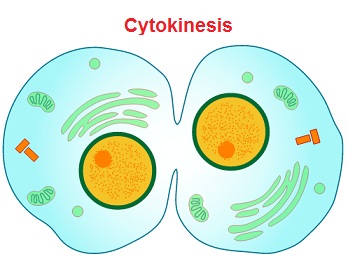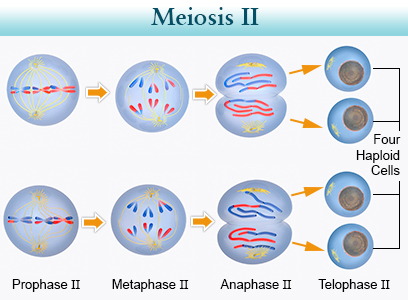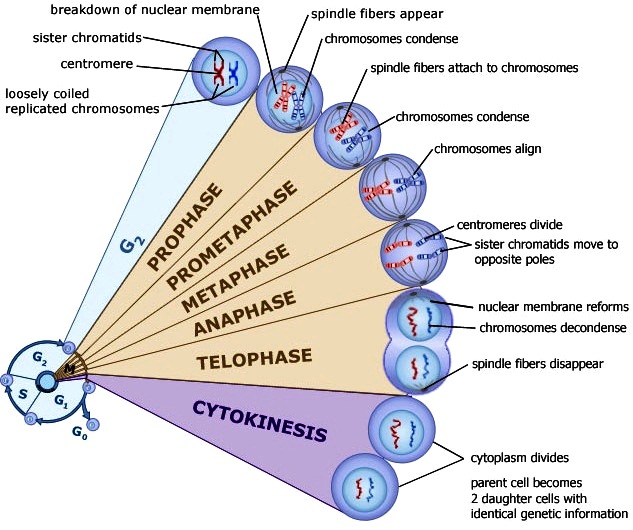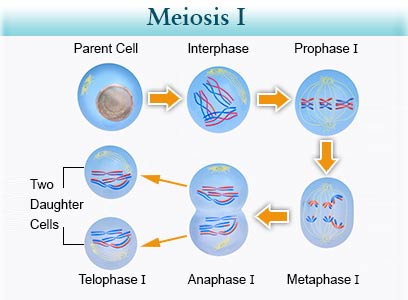Mitosis and Meiosis
Table of Content |
Mitosis
 (Gk. Mitos = thread; osis = state)
(Gk. Mitos = thread; osis = state)
(1) Definition : It is also called indirect cell division or somadtic cell division or equational division. In this, mature somatic cell divides in such a way that chromosomes number is kept constant in daughter cells equal to those in parent cell, so the daughter cells are quantitatively as well as qualitatively similar to the parental cell. So it is called equational division
(2) Discovery : Mitosis was first observed by Strasburger (1875) and in animal cell by W.fleming (1879) term mitosis was given by Fleming (1882).
(3) Occurrence : Mitosis is the common method of cell division. It takes place in the somatic cells in the animals. Hence, it is also known as the somatic division. It occurs in the gonads also for the multiplication of undifferentiated germ cells. In plants mitosis occurs in the meristematic cells e.g. root apex and shoot apex.
(4) Duration : It ranges from 30 minutes to 3 hours time is species-specific but also depends upon type of tissues, temperature.
(5) Process of mitosis : Mitosis is completed in two steps
Karyokinesis: (Gk. karyon = nucleus; kinesis = movement) Division of nucleus. Term given by Schneider (1887).
Cytokinesis: (Gk. kitos = cell; kinesis = movement) Division of cytoplasm, Term given by Whitemann (1887).
Karyokinesis
It comprises four phases i.e. Prophase, Metaphase, Anaphase, Telophase.
Prophase
It is largest phase of karyokinesis.
(a) Chromatin fibres thicken and shorter to form chromosomes which may overlap each other and appears like a ball of wool. i.e. Spireme stage.
(b) Each chromosome divides longitudinally into 2 chromatids which remain attached to centromere.
(c) Nuclear membrane starts disintegrating except in dinoflagellates.
(d) Nucleolus starts disintegrating.
(e) Cells become viscous, refractive and oval in outline.
(f) Spindle formation begins.
(g) Cell cytoskeleton, golgi complex, ER, etc. disappear.
(h) In animal cells, centrioles move towards opposite sides.
(i) Lampbrush chromosomes can be studied well.
(j) Small globular structure (beaded) on the chromosome are called chromomeres.
Metaphase
(a) Chromosomes become maximally distinct i.e. size can be measured.
(b) A colourless, fibrous, bipolar spindle appears.
(c) Spindle is formed from centriole (in animal cells) or MTOC (microtubule organising centre) in plant cells successively called astral and anastral spindle.
(d) Spindle has 3 types of fibres.
- Continuous fibre (run from pole to pole).
- Discontinuous fibre (run between pole to centromeres).
- Interzonal fibre (run between 2 centromere).
(e) Spindle fibre are made up of 97% tubulin protein and 3% RNA.
(f) Chromosomes move towards equatorial plane of spindles called congression and become arranged with their arms directed towards pole and centromere towards equator.
(g) Spindle fibres attach to kinetochores.
(h) Metaphase is the best stage for studying chromosome morphology.
Anaphase
(a) Centromere splits from the middle and two chromatids gets separated.
(b) Both the chromatids move towards opposite poles due to repulsive force called anaphasic movement.
(c) Anaphasic movement is brought about by the repolymerisation of continuous fibres and depolymerisation of chromosomal fibres.
(d) Different shape of chromosomes become evident during chromosome movement viz. metacentric acrocentric etc.
(e) Chromosomes takes V, J, I or L shapes.
(f) The centromere faces towards equator.
(g) The chromatids are moved towards the pole at a speed of 1 mm/minute. About 30 ATP molecules are used to move one chromosome from equator to pole.
Telophase
(a) Chromosomes reached on poles by the spindle fibers and form two groups.
(b) Chromosomes begin to uncoil and form chromatin net.
(c) The nuclear membrane and nucleolus reappear.
(d) Two daughter nuclei are formed.
(e) Golgi complex and ER etc., reform.
Cytokinesis
 It involves division of cytoplasm in animal cells, the cell membrane develops a constitution which deepens centripetally and is called cell furrow method.
It involves division of cytoplasm in animal cells, the cell membrane develops a constitution which deepens centripetally and is called cell furrow method.
In plant cells, cytokinesis occurs by cell plate formation.
Significance of Mitosis
(i) It keeps the chromosome number constant and genetic stability in daughter cells, so the linear heredity of an organism is maintained. All the cells are with similar genetic constituents.
(ii) It helps in growth and development of zygote into adult through embryo formation.
(iii) It provides new cells for repair and regeneration of lost parts and healing of the wounds.
(iv) It helps in asexual reproduction by fragmentation, budding, stem cutting, etc.
(v) It also restores the nucleo-plasmic ratio.
(vi) Somatic variations when maintained by vegetative propagation can play important role in speciation.
Types of Mitosis
(i) Anastral mitosis : It is found in plants in which spindle has no aster.
(ii) Amphiastral mitosis : It is found in animals in which spindle has two asters, one at each pole of the spindle. Spindle is barrel-like.
(iii) Intranuclear or Promitosis : In this nuclear membrane is not lost and spindle is formed inside the nuclear membrane e.g. Protozoans (Amoeba) and yeast. It is so as centriole is present within the nucleus.
(iv) Extranuclear or Eumitosis : In this nuclear membrane is lost and spindle is formed outside nuclear membrane e.g. in plants and animals.
(v) Endomitosis : Chromosomes and their DNA duplicate but fail to separate which lead to polyploidy e.g. in liver of man, both diploid (2N) and polyploid cells (4N) have been reported. It is also called endoduplication and endopolyploidy.
(vi) Dinomitosis : In which nuclear envelope persists and microtubular spindle is not formed. During movement the chromosomes are attached with nuclear membrane.
Meiosis
(Gk. meioum = to reduce, osis = state)
(1) Definition : It is a special type of division in which the chromosomes duplicate only once, but cell divides twice. So one parental cell produces 4 daughter cells; each having half the chromosome number and DNA amount than normal parental cell. So meiosis is also called reductional division.
(2) Discovery : It was first demonstrated by Van Benden (1883) but was described by Winiwarter (1900). Term “meiosis” was given by Farmer and Moore (1905).
(3) Occurrence : It is found in special types and at specific period. It is reported in diploid germ cells of sex organs (e.g. primary spermatocytes of testes to form male gametes called spermotozoa and primary oocytes to form female gametes called ova in animals) and in pollen mother cells (microsporocytes) of anther and megasporocyte of ovule of ovary of flowers in plant to form the haploid spores. The study of meiosis in plants can be done in young flower buds.
Process of Meiosis
Meiosis is completed in two steps, meiosis I and meiosis II
Meiosis I
In which the actual chromosome number is reduced to half. Therefore, meiosis I is also known as reductional division or heterotypic division. It results in the formation of two haploid cells from one diploid cell. It is divided into two parts, karyokinesis I and cytokinesis I.
Karyokinesis I
It involves division of nucleus. It is divided into four phases i.e. prophase, metaphase, anaphase, telophase.
Prophase I
It is of longest phase of karyokinesis of meiosis. It is again divisible into five subphases i.e. leptotene, zygotene, pachytene, diplotene and diakinesis.
Leptotene/Leptonema
(a) Chromosomes are long thread like with chromomeres on it.
(b) Volume of nucleus increases.
(c) Chromatin network has half chromosomes from male and half from female parent.
(d) Chromosome with similar structure are known as homologous chromosomes.
(e) Leptonemal chromosomes have a definite polarization and forms loops whose ends are attached to the nuclear envelope at points near the centrioles, contained within an aster. Such peculiar arrangement is termed as bouquet stage (in animals) and syndet knot (in plants).
(f) E.M. (electron microscope) reveals that chromosomes are composed of paired chromatids, a dense proteinaceous filament or axial core lies within the groove between the sister chromatids of each chromosome.
(g) Lampbrush chromosome found in oocyte of amphibians is seen in leptotene.
Zygotene / Zygonema
(a) Pairing or “synapsis” of homologous chromosomes takes place in this stage.
(b) Synapsis may be of following types.
-
Procentric : Starting at the centromere.
-
Proterminal : Starting at the end.
-
Localised random : Starting at various points.
(c) Paired chromosomes are called bivalents, which by furthur molecular packing and spiralization becomes shorter and thicker.
(d) Pairing of homologous chromosomes in a zipper-fashion. Number of bivalents (paired homologous chromosomes) is half to total number of chromosomes in a diploid cell. Each bivalent is formed of one paternal and one maternal chromosome (i.e. one chromosome derived from each parent).
(e) Under EM, a filamentous ladder like nucleoproteinous complex, called synaptinemal. Complex between the homologous chromosomes which is discovered by “Moses” (1953).
Pachytene/Pachynema
(a) In the tetrad, two similar chromatids of the same chromosome are called sister chromatids and those of two homologous chromosomes are termed non-sister chromatids.
(b) Crossing over i.e. exchange of segments between non-sister chromatids of homologous chromosome occurs at this stage.
It takes place by breakage and reunion of chromatis segments. Breakage called nicking, is assisted by an enzyme endonuclease and reunion termed annealing is added by an enzyme ligase. Breakage and reunion hypothesis proposed by Darlington (1937).
(c) Chromatids of pachytene chromosome are attached with centromere.
(d) A tetrad consists of two sets of homologous chromosomes each with two chromatids. Each tetrad has four kinetochore (two sister and two homologous).
(e) A number of electron dense bodies about 100 nm in diameter are seen at irregular intervals within the centre of the synaptonemal complex, known as recombination nodules.
(f) DNA polymerase is responsible for the repair synthesis.
Diplotene/Diplonema
(a) At this stage the paired chromosomes begin to separate (desynapsis).
(b) Cross is formed at the place of crossing over between non-sister chromatids.
(c) Homologous chromosomes move apart they remain attached to one another at specific points called chiasmata.
(d) At least one chiasma is formed in each bivalent.
(e) Chromosomes are attached only at the place of chiasmata.
(f) Chromatin bridges are formed in place of synaptonemal complex on chiasmata.
(g) This stage remains as such for long time.
Diakinesis
(a) Chiasmata moves towards the ends of chromosomes. This is called terminalization.
(b) Chromatids remain attached at the place of chiasma only.
(c) Nuclear membrane and nucleolus degenerates.
(d) Chromosome recondense and tetrad moves to the metaphase plate.
(e) Formation of spindle.
(f) Bivalents are irregularly and freely scattered in the nucleocytoplasmic matrix.
When the diakinesis of prophase-I is completed than cell enters into the metaphase-I.
Metaphase I
It involves;
(i) Chromosome come on the equator.
(ii) Due to repulsive force the chromosome segment get exchanged at the chiasmata.
(iii) Bivalents arrange themselves in two parallel equatorial or metaphase plates. Each equatorial plate has one genome.
(iv) Centromeres of homologous chromosomes lie equisdistant from equator and are directed towards the poles while arms generally lie horizontally on the equator.
(v) Each homologous chromosome has two kinetochores and both the kinetochores of a chromosome are joined to the chromosomal or tractile fibre of same side.
Anaphase-I
(i) It involves separartion of homologous chromosomes which start moving opposite poles so each tetrad is divided into two daughter dyads. So anaphase-I involves the reduction of chromosome number, this is called disjunction.
(ii) The shape of separating chromosomes may be rod or J or V-shape depending upon the position of centromere.
(iii) Segregation of mendalian factors or independent asortment of chromosomes take place. In which the paternal and maternal chromosomes of each homologous pair segregate during anaphase-I which introduces genetic variability.
Telophase-I
(i) Two daughter nuclei are formed but the chromosome number is half than the chromosome number of mother cell.
(ii) Nuclear membrane reappears.
(iii) After telophase I cytokinesis may or may not occur.
(iv) At the end of Meiosis I either two daughter cells will be formed or a cell may have two daughter nuclei.
(v) Meiosis I is also termed as reduction division.
(vi) After meiosis I, the cells in animals are reformed as secondary spermatocytes or secondary oocytes; with haploid number of chromosomes but diploid amount of DNA.
(vi) Chromosomes undergo decondensation by hydration and despiralization and change into long and thread like chromation fibres.
Interphase
Generally there is no interphase between meiosis-I and meiosis-II. A brief interphase called interkinesis, or intermeiotic interphase. There is no replication chromosomes, during this interphase.
Cytokinesis-I
It may or may not be present. When present, it occurs by cell-furrow formation in animal cells and cell plate formation in plant cells.
Significance of meiosis-I
(i) It separates the homologous chromosomes to reduce the chromosome number to the haploid state, a necessity for sexual reproduction.
(ii) It introduces variation by forming new gene combinations through crossing over and randon assortment of paternal and maternal chromosomes.
(iii) It may at times cause chromosomal mutation by abnormal disjunction.
(iv) It induces the cells to produce gametes for sexual reproduction or spores for asexual reproduction.
Meiosis-II
It is also called equational or homotypical division because the number of chromosomes remains same as after meiosis-I. It is of shorter duration than even typical mitotic division. It is also divisible into two parts, Karyokinesis-II and Cytokinesis-II.

Karyokinesis-II
It involves the separation of two chromatids of each chromosome and their movement to separate cells. It is divided in four phases i.e., Prophase-II, Metaphase-II. Anaphase-II and Telophase-II.
Almost all the changes of Karyokinesis-II resembles to mitosis which involves.
(i) It starts just after end of telophase I.
(ii) Each daughter cell (nucleus) undergoes mitotic division.
(iii) It is exactly similar to mitosis.
(iv) At the end of process, cytokinesis takes place.
(v) Four daughter cells are formed after completion.
(vi) The sister kinetochores of one chromosome are separated.
(vii) The four daughter cells receive one chromatid each of the tetravalent.
(viii) Centromere divide at anaphase II.
(ix) Spindle fibres contract at prophase II.
Cytokinesis-II
It is always present and occurs by cell furrow formation in animal cell and cell plate formation in plant cell.
So by meiosis, a diploid parental cell divides twice forming four haploid gametes or sex cells, each having half the DNA amount than that of the parental cell and one-fourth of DNA present in the cell at the time of beginning of meiosis.
Significance of Meiosis
(i) Constancy of chromosome number in successive generation is brought by process.
(ii) Chromosome number becomes half during meiosis.
(iii) It helps in introducing variations and mutation.
(iv) It brings about gamete formation.
(v) It maintains the amount of genetic informative material.
(vi) Sexual reproduction includes one meiosis and fusion.
(vii) The four daughter cells will have different types of chromatids.
Why the necessity of Meiosis-II
The basic aim of meiosis is to reduce the number of chromosomes to half. The chromosomes that separate in the anaphase of meiosis-I are still double. Each consist of two chromatids and has 2n amount of DNA. Thus reduction of DNA content does not occur in meiosis-I. Truely haploid nuclei in terms of DNA contents as well as chromosome number are formed in meiosis-II. When the chromatids of each chromosome are separated into different nuclei. Thus meiosis-II is necessary.
Difference between Mitosis and Meiosis
|
S.No. |
Characters |
Mitosis |
Meiosis |
|
|
I. General |
||||
|
(1) |
Site of occurrence |
Somatic cells and during the multiplicative phase of gametogenesis in germ cells. |
Reproductive germ cells of gonads. |
|
|
(2) |
Period of occurrence |
Throughout life. |
During sexual reproduction. |
|
|
(3) |
Nature of cells |
Haploid or diploid. |
Always diploid. |
|
|
(4) |
Number of divisions |
Parental cell divides once. |
Parent cell divides twice. |
|
|
(5) |
Number of daughter cells |
Two. |
Four. |
|
|
(6) |
Nature of daughter cells |
Genetically similar to parental cell. Amount of DNA and chromosome number is same as in parental cell. |
Genetically different from parental cell. Amount of DNA and chromosome number is half to that of parent cell. |
|
|
II. Prophase |
||||
|
(7) |
Duration |
Shorter (of a few hours) and simple. |
Prophase-I is very long (may be in days or months or years) and complex. |
|
|
(8) |
Subphases |
Formed of 3 subphases : early-prophase, mid-prophase and late-prophase. |
Prophase-I is formed of 5 subphases: leptotene, zygotene, pachytene, diplotene and diakinesis. |
|
|
(9) |
Bouquet stage |
Absent. |
Present in leptotene stage. |
|
|
(10) |
Synapsis |
Absent. |
Pairing of homologous chromosomes in zygotene stage. |
|
|
(11) |
Chiasma formation and crossing over. |
Absent. |
Occurs during pachytene stage of prophase-I. |
|
|
(12) |
Disappearance of nucleolus and nuclear membrane |
Comparatively in earlier part. |
Comparatively in later part of prophase-I. |
|
|
(13) |
Nature of coiling |
Plectonemic. |
Paranemic. |
|
|
III. Metaphase |
||||
|
(14) |
Metaphase plates |
Only one equatorial plate |
Two plates in metaphase-I but one plate in metaphase-II. |
|
|
(15) |
Position of centromeres |
Lie at the equator. Arms are generally directed towards the poles. |
Lie equidistant from equator and towards poles in metaphase-I while lie at the equator in metaphase-II. |
|
|
(16) |
Number of chromosomal fibres |
Two chromosomal fibre join at centromere. |
Single in metaphase-I while two in metaphase-II. |
|
|
IV. Anaphase |
||||
|
(17) |
Nature of separating chromosomes |
Daughter chromosomes (chromatids with independent centromeres) separate. |
Homologous chromosomes separete in anaphase-I while chromatids separate in anaphase in anaphase-II. |
|
|
(18) |
Splitting of centromeres and development of inter-zonal fibres |
Occurs in anaphase. |
No splitting of centromeres. Inter-zonal fibres are developed in metaphase-I. |
|
|
V. Telophase |
||||
|
(19) |
Occurrence |
Always occurs |
Telophase-I may be absent but telophase-II is always present. |
|
|
VI. Cytokinesis |
||||
|
(20) |
Occurrence |
Always occurs |
Cytokinesis-I may be absent but cytokinesis-II is always present. |
|
|
(21) |
Nature of daughter cells |
2N amount of DNA than 4N amount of DNA in parental cell. |
1 N amount of DNA than 4 N amount of DNA in parental cell. |
|
|
(22) |
Fate of daughter cells |
Divide again after interphase. |
Do not divide and act as gametes. |
|
|
VII. Significance |
||||
|
(23) |
Functions |
Helps in growth, healing, repair and multiplication of somatic cells. Occurs in both asexually and sexually reproducing organisms. |
||
|
(24) |
Variations |
Variations are not produced as it keeps quality and quantity of genes same. |
Produces variations due to crossing over and chance arrangement of bivalents at metaphase-I. |
|
|
(25) |
In evolution |
No role in evolution. |
It plays an important role in speciation and evolution. |
|
Types of Meiosis
On the basis of time and place, meiosis is of three types
(i) Gametic/Terminal meiosis : In many protozoans, all animals and some lower plants, meiosis takes place before fertilization during the formation of gametes. Such a meiosis is described as gametic or terminal.
This type of life cycle with diploid adult and gametic meiosis is known as the diplontic cycle.
(ii) Zygotic or Initial Meiosis : In fungi, certain protozoan groups, and some algae fertilization is immediately followed by meiosis in the zygote, and the resulting adult organisms are haploid. Such a meiosis is said to be zygotic or initial. This type of life cycle with haploid adult and zygotic meiosis is termed the haplontic cycle.
(iii) Sporogenetic Meiosis
(a) Diploid sporocytes or spore mother cells of sporophytic plant, undergo meiosis to form the haploid spores in the sporangia.
(b) Haploid spore germinates to form haploid gametophyte which produces the haploid gametes by mitosis.
(c) Haploid gametes fuse to form diploid zygote which develops into diploid sporophyte by mitotic divisions. e.g. In higher plants like pteridophytes, gymnosperms and angiosperms.
|
|


Q.1 Meiosis was discovered by [Bihar PMT 1994]
(a) Strasburger (b) Hofmeister
(c) Sutton (d) Amici
Q.2 In which of the following meiosis takes place [MP PMT 1992]
(a) Pollen grains (b) Pollen tube
(c) Pollen mother cells (d) Generative cells
Q.3 The significance of meiosis lies in [MP PMT 1995, 98]
(a) Reduction of the diploid number of chromosomes to haploid
(b) Maintaining constancy in the number of diploid chromosomes during sexual reproduction
(c) Production of genetic variability in the population of a species
(d) All of the above
Q.4 Prophase of reduction division is divided into number of stages. The correct chronological sequence is [CMC Vellore 1993; CPMT 1974, 96, 2000; KCET (Med.) 1999; Orissa PMT 2002]
(a) Leptotene – pachytene – zygotene – diplotene – diakinesis
(b) Leptotene – diplotene – pachytene – zygotene – diakinesis
(c) Leptotene – zygotene – diplotene – pachytene – diakinesis
(d) Leptotene – zygotene – pachytene – diplotene– diakinesis
Q.5 When during the meiotic division, do the homologous chromosomes pair with each other [MP PMT 1996]
(a) Leptotene (b) Pachytene
(c) Zygotene (d) Metaphase-I
Q.6 Repulsion of homologous chromosomes takes place in [MP PMT 2001]
(a) Zygotene (b) Leptotene
(c) Diakinesis (d) Diplotene
Q.7 Chiasmata formation occurs during [CPMT 1981, 89, 91; MP PMT 1984, 87, 94, 2002, 03]
(a) Diplotene (b) Leptotene
(c) Pachytene (d) Diakinesis
Q.8 In pachytene stage of meiosis the chromosomes appear [BHU 2002]
(a) Single stranded (b) Double stranded
(c) Three stranded (d) Four stranded
Q.9 Pachytene occurs during [MP PMT 1994]
(a) Meiosis (b) Mitosis
(c) Growth of a cell (d) Formation of endosperm
Q.10 Chromonemata start associating into bivalent chromosomes during [MP PMT 1997; J & K CET (Med.) 2002]
(a) Zygotene (b) Leptotene
(c) Pachytene (d) Diplotene


|
Q.1 |
Q.2 |
Q.3 |
Q.4 |
Q.5 |
|
a |
c |
sd |
a |
|
|
Q.6 |
Q.7 |
Q.8 |
Q.9 |
Q.10 |
|
d |
a |
d |
a |
a |
Related Resources
-
Click here to refer the Useful Books of Biology for NEET (AIPMT)
-
Click here for study material on – Biomolecules
To read more, Buy study materials of Cell Cycle and Cell Division comprising study notes, revision notes, video lectures, previous year solved questions etc. Also browse for more study materials on Biology here.




